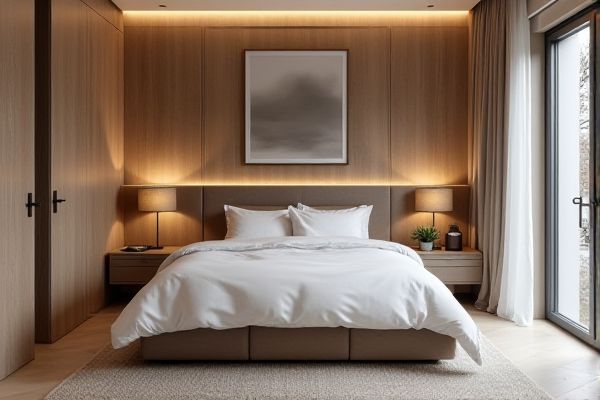
Alcove beds maximize space by fitting snugly into a recessed area, offering a cozy and integrated sleeping solution ideal for small rooms, while freestanding beds provide versatile placement options with a variety of styles and sizes. Discover which bed type best suits Your space and lifestyle by exploring the full comparison in the rest of this article.
Table of Comparison
| Feature | Alcove Bed | Freestanding Bed |
|---|---|---|
| Design | Built into a recess or nook, fixed placement | Standalone frame, movable |
| Space Utilization | Optimizes small spaces, fits flush against walls | Requires more surrounding space |
| Installation | Requires custom fitting or built-in carpentry | Simple assembly, no customization needed |
| Style Flexibility | Limited by alcove dimensions | Variety of styles and sizes available |
| Mobility | Fixed, not easily moved | Easy to relocate |
| Cost | Potentially higher due to customization | Generally lower, wide price range |
Introduction to Alcove Beds and Freestanding Beds
Alcove beds are built into a recessed space within a room, offering a custom, space-saving solution that seamlessly integrates with surrounding walls or cabinetry. Freestanding beds stand independently, allowing for greater flexibility in room layout and design, making them ideal for various interior styles and easy relocation. Understanding the distinction between alcove and freestanding beds helps you choose the best option for maximizing space and aesthetic harmony in your bedroom.
Design and Structural Differences
Alcove beds are designed to fit snugly between three walls, creating a built-in appearance that maximizes space and provides a cozy, enclosed sleeping area. Freestanding beds have a standalone frame that can be positioned anywhere in a room, offering greater flexibility in interior layout and design. Structurally, alcove beds often feature integrated headboards and storage options within the surrounding walls, while freestanding beds rely on separate furniture pieces to complement their aesthetic and functionality.
Space Efficiency and Room Layout
Alcove beds maximize space efficiency by utilizing recessed wall areas, making them ideal for small rooms or apartments with limited floor space. Freestanding beds require more clearance on all sides, influencing room layout flexibility but allowing easier repositioning and decoration changes. Choosing an alcove bed optimizes floor space and fosters a streamlined, integrated design, while freestanding beds provide versatile arrangements at the cost of spatial economy.
Comfort and Sleeping Experience
Alcove beds provide a cozy, enclosed space that can enhance your sleeping experience by reducing noise and drafts, creating a sense of privacy and security. Freestanding beds offer more flexibility in placement and style, allowing you to customize your comfort with various mattresses and frames. Choosing between these options depends on your preference for enclosure versus openness, impacting how restful and comfortable your sleep will be.
Storage and Organizational Options
Alcove beds maximize storage with built-in shelves, drawers, and overhead cabinets integrated into wall recesses, ideal for compact spaces needing efficient organization. Freestanding beds offer versatile storage through under-bed drawers, storage headboards, or separate furniture but require extra floor space for additional units. Your choice depends on whether you prioritize seamless, space-saving storage solutions with an alcove bed or flexible, movable storage options with a freestanding bed.
Installation and Mobility
Alcove beds require fixed installation within a recessed wall space, offering a space-saving and permanent solution that maximizes room layout efficiency. Freestanding beds offer greater mobility, allowing easy relocation and repositioning without structural modifications, ideal for renters or those who frequently change room configurations. Choosing between the two depends on whether permanent installation or flexible mobility is a priority for bedroom design and space management.
Style and Aesthetic Appeal
Alcove beds create a cozy, built-in look that maximizes space and offers a seamless integration with your room's design, often featuring surrounding shelves or cabinetry for added functionality. Freestanding beds provide versatility in style, allowing you to easily change your bedroom's aesthetic with various headboard designs, materials, and colors. Your choice depends on whether you prefer a tailored, space-saving alcove that blends into the room or a standout freestanding bed as a focal point.
Cost Comparison and Value
Alcove beds typically cost more upfront due to custom fitting and built-in cabinetry, offering integrated storage and space-saving benefits that enhance long-term value. Freestanding beds often provide lower initial prices with greater flexibility in style and placement but may require additional furniture purchases for storage. When assessing cost versus value, alcove beds deliver durable, multifunctional solutions ideal for small spaces, while freestanding beds appeal to budget-conscious buyers prioritizing versatility.
Maintenance and Longevity
Alcove beds benefit from reduced exposure to dust and environmental damage due to their recessed placement, resulting in lower maintenance needs and enhanced durability. Freestanding beds may require more frequent cleaning and care as all sides are exposed to potential wear and tear. Your choice should consider how maintenance efforts align with the desired lifespan and usage frequency of the bed.
Choosing the Right Bed for Your Home
An alcove bed fits snugly into a recessed space, maximizing room efficiency and providing built-in storage options that free up floor space. Freestanding beds offer greater flexibility in placement and design, allowing you to easily rearrange your bedroom or replace the bed without structural limitations. Choosing the right bed for your home depends on your room layout, storage needs, and whether you prefer a fixed or adaptable furniture piece.
 homyna.com
homyna.com